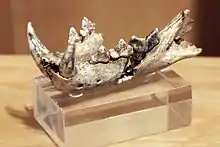| Cave lynx | |
|---|---|
 | |
| Jaw bone fossil | |
| Scientific classification | |
| Domain: | Eukaryota |
| Kingdom: | Animalia |
| Phylum: | Chordata |
| Class: | Mammalia |
| Order: | Carnivora |
| Suborder: | Feliformia |
| Family: | Felidae |
| Subfamily: | Felinae |
| Genus: | Lynx |
| Species: | |
| Subspecies: | †L. p. spelaeus |
| Trinomial name | |
| †Lynx pardinus spelaeus Boule, 1910 | |
The cave lynx or Mediterranean cave lynx (Lynx spelaeus or Lynx pardinus spelaeus) is an extinct felid species that lived during the Pleistocene. It is controversially discussed to be a subspecies of the modern Iberian lynx (Lynx pardinus) and to be a junior synonym of this species.[1]
Fossils have been found from the Middle and Late Pleistocene in Italy and France.[2] Body mass reconstructions estimate this lynx to weigh about 23 kg.[3]
References
- ↑ Boscaini, Alberto; Alba, David M.; Beltrán, Juan F.; Moyà-Solà, Salvador; Madurell-Malapeira, Joan (2016). "Latest Early Pleistocene remains of Lynx pardinus (Carnivora, Felidae) from the Iberian Peninsula: Taxonomy and evolutionary implications". Quaternary Science Reviews. 143: 96–106. Bibcode:2016QSRv..143...96B. doi:10.1016/j.quascirev.2016.05.015.
- ↑ Ghezzo, Elena; Boscaini, Alberto; Madurell-Malapeira, Joan; Rook, Lorenzo (2015). "Lynx remains from the Pleistocene of Valdemino cave (Savona, Northwestern Italy), and the oldest occurrence of Lynx spelaeus (Carnivora, Felidae)". Rendiconti Lincei. 26 (2): 87–95. doi:10.1007/s12210-014-0363-4. hdl:11336/59435. S2CID 85194755.
- ↑ Carlo Meloro (2007). "Plio-Pleistocene large carnivores from the Italian peninsula: functional morphology and macroecology". Università degli Studi di Napoli “Federico II”.
This article is issued from Wikipedia. The text is licensed under Creative Commons - Attribution - Sharealike. Additional terms may apply for the media files.